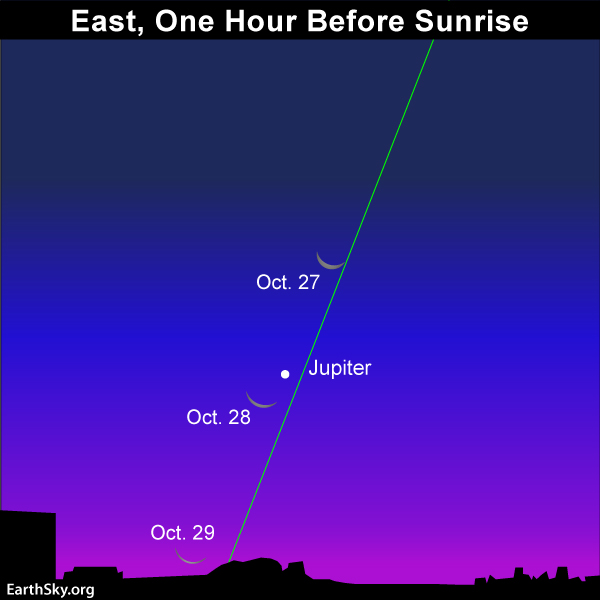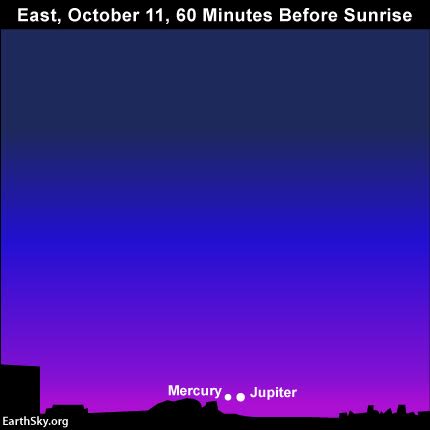Before dawn tomorrow – October 11, 2016 – look for the second-brightest planet Jupiter now emerging from the dawn. Another planet, Mercury, will be near it. Our chart says to look 60 minutes before sunrise, but your specific timing may not be that, exactly. We can’t tell you exactly when to look. That’ll depend on your location on the globe and the conditions of your particular sky.
We can tell you to look shortly before sunrise, when dawn is just beginning to light the sky. The two planets are very near the sunrise point. Jupiter is brighter. Mercury may require binoculars (or a telescope, or telephoto lens) to be seen.
You’ll need to look as dawn is breaking, but not so far into dawn’s light that the sky is washed with the light, so that no planet can be seen.
And, so, you see … the timing for seeing them needs to be very exact. The only way to find them is to go outside and look! Start trying to see them when the first glimmers of dawn appear in the east, and keep trying – every 5-10 minutes – until you spot them. Jupiter is brighter, and Mercury is much fainter.
Officially, Jupiter passed into the morning sky during September, but, actually, it’s only now emerging from dawn’s glare. And Mercury swung to its greatest morning elongation from the sun on September 28, presenting a fine morning apparition of Mercury in the Northern Hemisphere (and not as good for the Southern Hemisphere). Now Mercury is much lower in the sky than it was in late September.
If you are blessed with clear predawn skies, watch for the conjunction of Mercury and Jupiter on the morning of October 11, 2016. See the sky chart at the top of this post, which gives the Northern Hemisphere view.
From northerly latitudes, Jupiter should be relatively easy to spot, with Mercury more difficult.
From temperate latitudes in the Southern Hemisphere, the ecliptic – or path of the sun, moon and planets – slants low in the predawn sky. Thus Jupiter might not be visible to the eye before sunrise until late October or November, but photographers and those with optical aid can try their luck!
Click here for recommended almanacs; they can give you Mercury’s rising time in your sky.
After their conjunction tomorrow, as the October mornings pass, Mercury will become lost in the sun’s glare, but Jupiter will be climbing up and away from the sunrise, getting more and more noticeable, even to those who are not searching for it.
If you are blessed with an unobstructed horizon in the direction of sunrise, watch the waning crescent moon with Jupiter on October 27 and October 28.
At that time, the moon and Jupiter – though still harder to see from southerly latitudes – may be visible to the eye in the Southern Hemisphere. Have binoculars handy for sweeping near the sunrise horizon!

Bottom line: Watch for the conjunction of Jupiter and Mercury – in the east before dawn – on the mornings around October 11, 2016. Binoculars, a telescope, or a telephoto lens might help!












